Guitar Amplifier Guide
Your guitar amplifier can make the difference between really enjoying the great tone of your guitar, or creating frustration from lack of features, lack of volume, humm, or other problems.
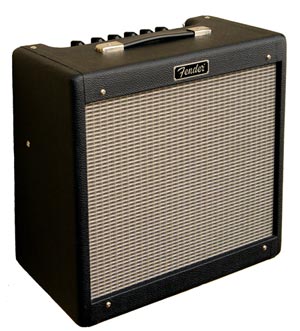 |
How An Amplifier Works
To understand why you might want to purchase one type of amplifier over another, you first need to understand the basic components that make guitar amplification possible.
Many of the boxes sold as guitar amplifiers are actually a combination amplifier, effects processors, and one or more speakers. Technically, the "amplifier" is just one part of the system... the part that increases the signal from your guitar so you (and others) can hear it. The rest of the box is: the cabinet, to hold all the other components; the effects processors, to modify the incoming sound; front panel knobs, dials or buttons, to control the volume and effects; and the speakers, so produce audible sound.
Amplification Illustrated
Take a look at the illustration, below. It's a simplified look at the actual amplification part of the system. Working from left to right, here's what might happen:
- The cable from your guitar plugs into the Input Jack.
- Sound from your guitar enters a Pre-Amp as a weak signal. The Pre-Amp increases it's strength slightly.
- The signal might pass through one or more devices that alter the signal, creating effects such as distortion.
- A master volume control determines how much strength the signal should have as it exits the amplifier.
- A second signal amplification device increases the signal.
- The signal passes on to a speaker (either built in to the same box, or connected by a cable).

Not All Amplifiers Are The Same
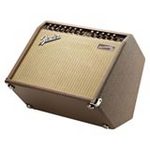 |
Manufacturer's build and market guitar amplifiers specifically for acoustic guitars, electric guitars, bass guitars, voice, and for other purposes.
So, unless you want to experiment or find a unique sound, start with an amplifier made for your type of instrument.
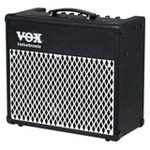 |
Most manufacturer web sites, product guides, and online store-fronts make it clear which amplifiers are made for a particular type of instrument.
An Amplifier For Every Budget
Mass production, global workforces, and intense competition mean that today's guitar amplifiers are better quality and lower-cost than ever before. Computer and transistor technologies provide improved sound processing and a wide variety of sound effects.
Want feedback? Modern amps can simulate it. Like reverb? It's getting hard to find an amplifier without it. Want echo, tone shift, play-along percussion, or a built-in tuner? How about recreating a famous amplifier no longer in production? Modern amplifiers can provide all these features.
In general, more extensive features and power drive costs up. However, some of the very best guitar amplifiers at both ends of the price spectrum do little more than increase the volume of the sound you send it... but they do this one thing very well. The key cost factors with such bare-bones amplifiers are power (the ability to produce loud volume) and purity of sound.
Take heart, while writing this I surveyed prices and found a number of very good amplifiers, with generous features, for less than $300 (USD).
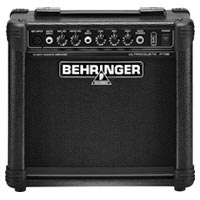 |
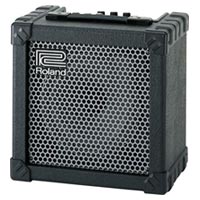 |
The Behringer ULTRACOUSTIC AT108 (left, for acoustic guitars) and the Roland Cube 15X
(right, for electrics) are great budget amps. For under $100 you get a CD input, headphone jack, and enough power to fill a room.
Many Shapes and Sizes
When you begin shopping for an amplifier, you will find numerous shapes, sizes and configurations. Don't worry, after reading this amplifier guide you will understand the combinations available, and be ready to select the right amp for you.
All In One Combo Systems
The most popular and versatile guitar amplifier is the Combo Amp. Think 'Combination of Everything'. It's a convenient, all-in-one package. Amplification, speakers, inputs, special effects. What more could you ask for?
You can find a combo amp of just about every shape and size, for just about any need, in a wide range of prices. For a beginner player, it's hard to recommend anything else.
Of course...
A Head + A Cabinet = A Stack
For players who need power, and lots of it... or who need power now and MORE POWER in the future... a stack is the way to go.
To put a stack together, you need at least two boxes: the Head and a Cabinet.
Imagine if a snowman were your guitar amplifier ;-)
If he was made of amplifier stack parts, his head would be the Amp Head (the power part of the system). His eyes, nose, etc. would be the built-in effects controls, and our snowman's body would be one or more speaker cabinets.
Manufacturers produce heads of various power ratings. They also make cabinets to match the appearance of their heads. This way, when you place a head on a matching cabinet it looks like a set. In addition, the matched cabinet provides a stable platform.
The primary advantage of a stack is the flexibility you have to change your set up over time as your needs change. Need more power? Sell your head and buy one that pumps out more volume. Need additional effects? Plug in an effects processor. Want more bass response? Get a new speaker cabinet. On the down side... combo's take up more space, tend to be more expensive, and are less portable than all-in-one combo systems.
Transistors or Tubes?
Yes... they still make tubes... musicians love them and no amplifier guide is complete without discussing them!
Tubes are still used because of the tone they help produce. There are players, engineers, and audiophiles who believe that the warmest tones and best sounds can only be obtained with a tube-based guitar amplifier.
You can affect the sound of a tube amp when you replace burned-out tubes. You must match tube types (a square peg won't fit in a round hole), but tubes from a different manufacturer may change your sound in subtle, or obvious ways. Various manufacturers try to differentiate themselves with subtle engineering differences and slight differences in sound reproduction. This may or may not be important to you.
For many years, all guitar amplifiers were built around tubes. The mass production of transistors allowed manufacturers to experiment with them in amps. In general, transistors are cheaper, less likely to burn out, and can be controlled more precisely than tubes. Ironically, today's transistor amplifier systems are often programmed to replicate the sounds produced by the classic tube-based systems.
Are tubes right for you? Would you be happier with an all-transistor system? A transistor amp is more likely to include more extra effects than a tube amp. But the bottom line will be the sound of your guitar with no effects at all. So, the only way to decide between tubes and transistors is to listen to a few of each type, then decide which you like best.
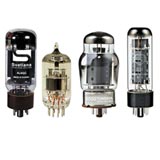 The two main drawbacks of tube amplifiers are: tubes eventually wear out and must be replaced; tube-based amps are more expensive than transistor based amps.
The two main drawbacks of tube amplifiers are: tubes eventually wear out and must be replaced; tube-based amps are more expensive than transistor based amps.
For a more in-depth explaination of tubes, see the Amplifier Tubes Explained page.
Guitar Amplifier Buying Tips
Choose Carefully
First, don't underestimate the progress you can make in just a couple years.
Today you may think any guitar amplifier will do. But, before you now it you'll need to produce enough volume to be heard along with a group of friends... perhaps in a basement, or maybe a community center or church hall. An amp that is OK at home in a bedroom is wholly inadequate for spacious rooms.
So, choose carefully. You want an amp that has enough power to grow with your developing talent for at least two or three years.
Listen Carefully
The key to selecting a great amplifier is not how great you can play, it's how well the amp sounds. A great musician can make you ignore the flaws of an O.K. amp, but you're not a great musician yet, and you don't want an O.K. amp!
If you can, play through every amp you're interested in. Get a sense for it's tone, but also listed to how quiet it is when you're not playing anything at all. Avoid any guitar amplifier that puts out any loud sound when nothing is connected to it: hum, hiss, crackle... anything loud.
Get a guitar amplifier that is capable of producing great sound, even at medium volume levels.
What's a medium volume level? Loud enough to get your parents or room-mate to complain.
You don't need anything louder. If you ever need to produce more sound you can either purchase a new, more powerful amp and cabinet, or use a microphone to pump your amplifier output into a P.A. system.
Nothing will discourage a new player more than the inability to have fun and produce improved tone over time... so go for great sound.
Check The Controls
The controls (knobs, dials, sliders) should be easy to use. They should have a smooth feel to them and you should be able to hear the effect when you increase or decrease each knob.
Are The Effects Effective?
The number of effects is only important if you'll use each one. Chance are you'll play with most of the effects, set the amp the way you like the sound, and almost never adjust them again.
What effects and controls should you consider? Nearly every amp should have the basics: volume, bass, and treble. Other important effects and features are: reverb, an auxilliary input (for a CD, MP-3 player, or other accompaniment, headphone output.
If your guitar uses an XLR output, then you want a balanced input jack.
Get Informed Opinions
When you've never shopped for a guitar amplifier before, where do you start? What's a good company? Which model is a great deal? No amplifier guide can answer these questions for every player... so, get informed opinions. How? Ask your instructor, ask your friends, or rely upon web-sites that provide user reviews, such as Musician's Friend.
How Much Should You Pay?
The Amplifier Guide "Rule of Thumb": be prepared to pay up to what you paid for your guitar. However, good starter amplifiers are available starting at about $100, and there are many very good amps in the $300-$400 range.
Amplifier Guide Bottom Line
Don't skimp on your first amplifier. A less expensive electric guitar can be upgraded piece by piece, a flawed amp cannot. If you purchase an amp that performs O.K., you'll quickly come to dislike its sound more than you disliked its price.


